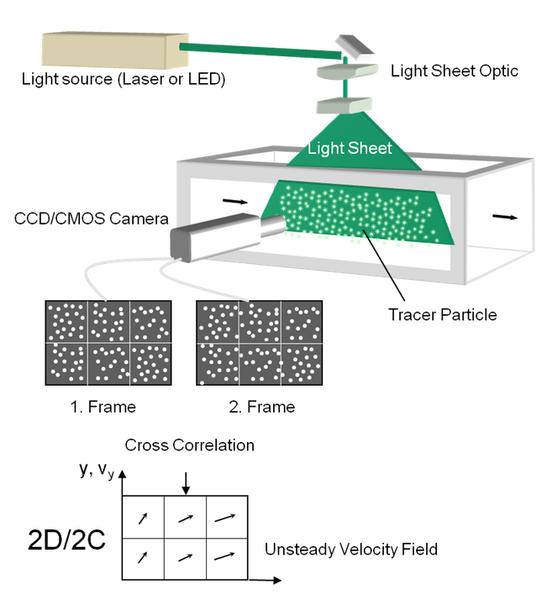Particle Image Velocimetry (PIV) principle
Contact
Dr. William Thielicke
E-Mail: thielicke@optolution.com
Telefon: +49 (0)7621 582 83 46
Particle Image Velocimetry is a non-intrusive, laser optical technique used for determination of the velocity distribution in fluids. The complexity of a system varies with the type of application, however, the basic principle of PIV stays the same:
In PIV, the motion of a fluid (either gaseous or liquid) is visualized by illuminating a thin sheet of fluid containing reflective and neutrally buoyant tracer particles. A digital camera is positioned parallel to the illuminated sheet, capturing the movement of the particles. In most PIV analyses, two images (A and B) of the illuminated plane are captured at t0 and t0+Δt. Velocities in the sheet can hence be derived from Δt and the distance that the particles travelled from image A to B (particle displacement). The particle displacement is calculated for groups of particles by evaluating the cross-correlation of many small sub-images (interrogation areas). The correlation yields the most probable displacement for a group of particles travelling on a straight line between image A and image B.

Messverfahren Particle Image Velocimetry
Recommended literature:
- M. Raffel, C. Willert, J. Kompenhans: Particle Image Velocimetry. Springer, 2000
- H. Nobach: Optische Messtechnik. Edition Winterwork, 2012
Video examples:
YouTube: Privacy policy for external media
This video cannot be viewed due to your privacy settings.
Please enable External Media to view this video.
YouTube: Privacy policy for external media
This video cannot be viewed due to your privacy settings.
Please enable External Media to view this video.
YouTube: Privacy policy for external media
This video cannot be viewed due to your privacy settings.
Please enable External Media to view this video.